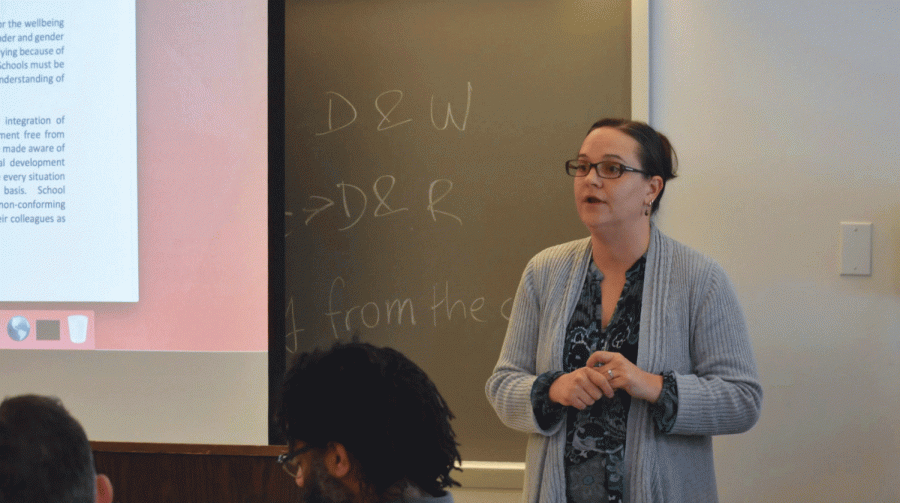Woolley Investigates Transgender Rights in NYC Public Schools
Professor Woolley (above) reflects on her research about Transgender Rights in NYC Public Schools. The NYC Department of Education recently changed its policies regarding transgender students.
On Thursday, February 1, Professor of Educational and LBGTQ Studies Susan Woolley presented her investigations into the LGBTQ+ communities’ struggle for fundamental rights within public schools in New York City.
Woolley focused on the controversy surrounding bathrooms as a safe space for transgender students.
The NYC Department of Education recently created a new policy illustrating how to provide transgender students with a safe and supportive learning environment. They recently expanded their two-page guideline on how to comply with the policy to 11 pages. In the revised description, the NYC Department of Education included extensive resources and suggestions on how to implement the policy within schools.
There are more specific instructions on addressing privacy concerns, harassment, dress codes, sports teams, locker rooms, restrooms and general gender separation in other areas such as lines in the hallways or field trips.
In addition, the department created a program for students to be able to change their names and pronouns in the school’s current records as well as indicate whether or not they want the same name used when making calls to home.
Through the use of interviews, surveys and ethnographic observations, Woolley set out to answer three main questions: how are NYC public schools implementing these new guidelines, how are teachers being informed about these guidelines and how to implement them, and how can one conceptualize and address the gap between education practice and policy in this case? Woolley and her research assistants contacted every public school in the city, which came out to a total of 1,835 schools. 75 schools were willing to participate.
Woolley and her assistants found a lack of uniform implementation and awareness across K-12 schools in NYC. Furthermore, schools that had been educated on how to support transgender students still struggled to provide support to non-binary members of their community. Woolley reported that 48 percent of students have no gender-neutral or all-gender facilities at school and most teachers are not well-informed about the new guidelines. Even educators who are knowledgeable and active are self-informed or were to learn by their own experience as a member of the LGBTQ+ community.
Woolley described the experience of a teacher who refrains from eating or drinking at school in order to avoid using the bathroom. This led to the teacher’s hospitalization for dehydration this fall. Woolley concluded that even the schools which take action are reacting to student or family concern, which establishes a precedent that if students are not publicly out, they do not exist in the eyes of the administration. Instead, Woolley believes that schools should be proactive by providing support before complaints are raised to provide the transgender and nonbinary population support without requiring that they publicly out themselves.
Woolley states that even though the flexibility of the Department of Education’s (DOE) guidelines emphasizes accommodation for the diversity of situations, more structure is required to fully integrate the guidelines into the school systems.
Master of Arts and Sciences (MAT) student at Colgate Ned Campbell experienced mixed emotions about Woolley’s information.
“[It was] good to see that guidelines for creating an inclusive environment have been created in New York, but frustrating to see such clear resistance,” Campbell said.
Junior Tabitha Gomez felt inspired by Woolley’s research, particularly because of her familiarity with the NYC public school system.
“As someone who attended NYC public schools and also wishes to teach in urban public schools, I was not surprised by the data,” Gomez said. “I personally hope as a future educator I can contribute to making urban public education a more inclusive environment for all students.”
Contact Kelsey McGeough at [email protected].
Kelsey McGeough is a senior from Weston, Massachusetts concentrating in English. She’s previously served as a news editor and staff writer. She is involved...




